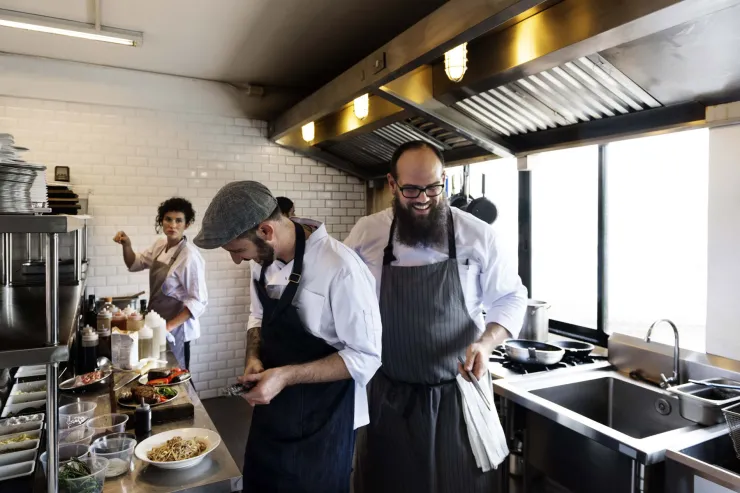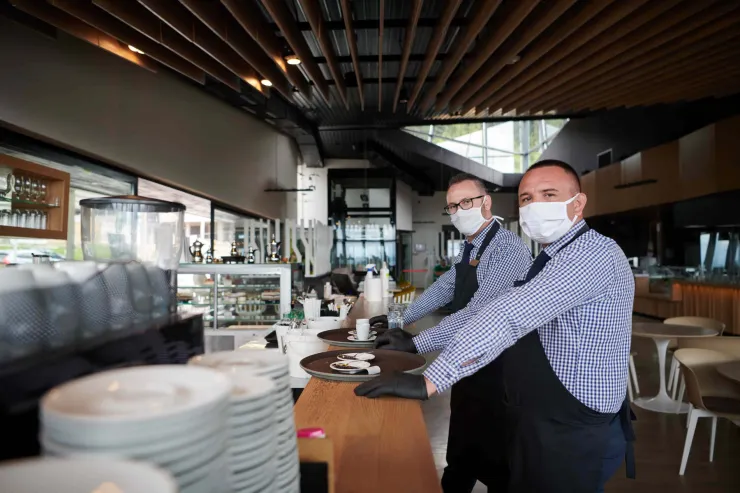Hiring restaurant staff has never been easy. And though many restaurants around the world have reopened or are reopening for hospitality — and customers are itching to get out — now there is an added layer of difficulty.
During the pandemic, many hospitality workers on seasonal or temporary visas returned to their home place. Add to this, some restaurant workers still do not feel safe returning to work. Some restaurant staff have gotten out of the industry completely. This has led to staff shortages in towns, cities and seasonal hotspots.
Family and friends are pitching in to help restaurant businesses, while restaurant staff and owners are working across roles to keep service going. This also makes shadowing while training new staff all the more difficult.
So when you do manage to hire and train in restaurant staff, you certainly want to hang onto them. All this combined means it’s never been more important to ensure your working environment is safe, that expectations are clear, and that retention processes are in place.
Let’s dig a little deeper.
How to hire restaurant staff

1. Revise CVs that have been dropped in
Sometimes the old ways are the best ways. If you have a bundle of CVs that have been hand-delivered to the premises, you already have some hot leads of people who are interested in working at your restaurant and are geographically close.
Start your hunt by revising these and following up with potential candidates. It is helpful going-forward if whoever takes in the CVs — ideally the restaurant manager — writes the date on top, and adds any relevant notes on first impressions. For example, it could be noted that the applicant had a particularly good attitude.
2. Offer the living wage, and a mix of full-time and part-time roles
There are a lot of variables to consider here. Depending on the town, city, state, or country, a living wage will vary hugely. There is no blanket rule that works for all here, and it is especially complex in many US states where the tipped wages can mean restaurant employees can earn more than minimum wage.
But, it is worthwhile going beyond the minimum wage to offer a living wage. You need restaurant staff, and so do your competitors. You need to create an attractive proposition, and providing a living wage means employees do not need to work multiple jobs.
You can find calculations for living wages for your area online, but if not, do some research and consider local costs of housing, food, health care, childcare, and transportation before defining your offering. Also be upfront for any additional payment for working with hazardous chemicals and manual handling.
To cast your net wide, offer a mix of full-time and part-time roles. Many potential employees have caring responsibilities or educational commitments that mean they can only work part-time. It is more paperwork for you, but flexibility can be a real draw for potential employees.
3. Canvas your network for word of mouth recommendations
A word of mouth recommendation is golden, and the restaurant business knows this more than most. When it comes to hiring, a recommendation from a staff member, friend or family can be a good shortcut to finding talent.
However, don’t rely solely on word of mouth recruitment. Through word of mouth-only, you could be unintentionally discriminating against potential applicants from different backgrounds and communities, those with differing abilities, or you could be discriminating on the basis of gender or age.

4. Post ads in your window and on social media
Again, to cast your net wide, use analogue and digital to maximise your reach. If CVs tend to go missing in your restaurant, ensure your window ad invites applicants to drop in a hard copy and to email in a soft copy too. Now is not the time to let potential employees fall through admin cracks.
5. Advertise in local media and online
Depending on the size of your restaurant, advertising tactics will vary hugely. Local radio stations often have editorial job spots where they list out new job offerings, while others may require payment for placement. Consider local newspapers, print and online, for classifieds too. Or better yet, pitch your business as an editorial story for expanding and mention you are employing X amount of new staffers in the area. Any Covid-19 safety measures you reiterate can be helpful to reassure applicants here too.
How to train restaurant staff

1. Conduct formal onboarding training
There’s nothing like learning on the job, and when staffing is so short, it can be tempting to skip formal onboarding. Don’t. It will only cause you more pain in the long run.
There is a lot about your restaurant that is second nature to you, so it can be difficult to see it from an outside perspective, but there is a lot to know.
Add to this, in many countries, staff turnover can be quite high in the restaurant industry. It can be worth creating a welcome handbook with comprehensive information on how the restaurant works, and this can be backed up with a Q&A session and relevant training.
Your restaurant handbook might include:
How your restaurant operates
Covid-19 safety protocols
The restaurant’s unique selling point (USP)
The restaurant’s etiquette for greeting and communicating with customers
The ethos behind your restaurant menu
The menu items currently available
The stars of the menu
Sommelier notes and/or training
Food provenance and suppliers
Responsible service of alcohol policy
Restaurant uniforms
Staff processes and policies for rosters, annual leave, sick leave and complaints
Roles and responsibilities for each staff member
Tech how-tos for online ordering systems, POS systems, last mile delivery services etc.
First aid and fire safety policies and training
Manual handling and hazardous chemicals training
Depending on the size of your restaurant, it might be worth connecting with an online compliance course company. In many larger operations, staff must complete and pass a quiz on an external site to get on the roster, but remember to give adequate time to complete the assignment.
Onboarding isn’t a one-way street either. Host a formal meeting for Q&As, and always be open and encourage questions. There’s never one way to do things, and you never know, a new perspective could make all the difference.

2. Allow for shadowing
As well as an interview can go, and as good as references can be, you only really know how someone is to work with once you’ve actually worked with them. Offer applicants a paid trial for three to four hours during a busy period. Do note that as staffing shortages are common across the industry, it’s likely they will be shadowing someone doing a hybrid of roles, which may make it even more confusing.
Of course, they are not going to perform the job perfectly, but you will have a sense of their attitude and way of working after this. It also gives the potential employee a chance to understand what working in your restaurant is like. It might not be for them, and this will save pain on both sides in the long run.
Once they onboard, for at least their first week, let them shadow an experienced staff member. If they are a new server for example, they can observe how the experienced server interacts with customers and back of house, they can see processes in action and can also be helpful by carrying plates and clearing tables. Most importantly, they can ask questions in a friendly peer-to-peer environment and build their first workplace relationship.
3. Be approachable
It is important for restaurant owners and managers to be approachable. You want new staff to ask questions. Remind yourself of all the information that is in the handbook and all the knowledge you have acquired over the months and years. This takes time. Give your time generously to staff and you will build loyalty.
4. Expect mistakes
Every new staff member will make a mistake, or two (or three or four). This is all part of the process. Remember the phrase “to err is human, to forgive divine” so remain approachable to nip mistakes in the bud. The last thing you want is an employee being too afraid to raise their head above the parapet and to be quietly making the same mistakes over and over.
5. Keep education continuous
Education can be formal and informal. From a very practical point of view, staff need to be regularly informed of menu updates, supplier changes and tech improvements that will affect their day-to-day. This can be a weekly email and/or series of short meetings across shifts so that staff have options for attending. Formally, there are a number of ways a restaurant owner or manager can support professional development and we’ll look at these in more detail in the next section.

How to retain restaurant staff
1. Offer flexibility
This has always been important in the restaurant industry, particularly when it comes to employees with caring responsibilities and educational commitments. However, flexibility has become even more important since the Covid-19 pandemic began.
Your staff need to know that you are understanding and flexible should they develop symptoms of feeling unwell, or if a close family member or contact becomes sick. Schools and childcare may be closed or operating at a limited capacity in your area also and this can affect parents and guardians’ working hours.
Be mindful of these added complications and create a process where shifts can be picked up by other staff members. Fostering a sense of team spirit is key to navigating this, which brings us neatly onto our next point.
2. Make it fun
Team bonding is important in every industry, but especially so in the restaurant trade where kitchens can be high-stress and front of house staff can be dealing with prickly customers and situations. As well as keeping the mood light by being approachable on the floor and by encouraging questions, healthy competition and wagers, it is also worthwhile organising specific bonding activities.
Organise menu training days — or hours, if the menu changes very regularly. This way restaurant staff can taste new menus first, and are paid for the pleasure. Here all employees have an opportunity to ask questions and really understand the product in a very enjoyable way. This also works for tasting new wines and spirits, and ultimately provides a better customer experience too.
You can also get out of the restaurant and try something new. Whether that’s a new food or drink experience locally, a night away, or a trip to a distillery or brewery. Or you could try sports related activities too, such as bowling, kayaking or abseiling. Build a sense of community, and you’ll see that staff are less likely to look elsewhere.

3. Be straight up about tips and time off
Of course, retaining staff isn’t about lavishing them with perks, you have to get the basics right first. One particular bugbear in restaurants is tips. You need to be upfront about how tipping works in your restaurant, ideally in your restaurant handbook.
In your restaurant, are the tips you make your own? Or do back of house, such as dishwashers, get included in a pool? Try delegating a staffer tip treasurer to manage this, as no one likes to see a tip jar disappear into a manager’s office. Keep things transparent. On the same lines, it is also worth including a salary range in the handbook for each position. For example, listing that your server pay scale is “from €12.30 – €14 per hour”.
For fairness, you also need to ensure there is a good rotation of who gets the busy tables and stations, and who works busy shifts and who doesn’t. Typically staff do want a mix of busy weekend shifts with better tips and also weekends off with their families and friends, but everyone’s motivations are different. You won’t know until you ask.
Hang a time off request sheet for shifts on the wall in the staff room or back of house, and while nothing can be guaranteed, you can try to accommodate as much as possible with adequate notice.
4. Show appreciation
As restaurants can be so unpredictable and busy periods can arrive out of nowhere, and staffers can call in sick, it’s likely that as a restaurant manager or owner you will at some point be asking favours of employees. These can include coming in to cover a shift or delaying a break. If you do ask a favour, ensure it is framed as a request and not a “non-negotiable request”. If you’ve already ticked all boxes on the above and relationships are strong, this all helps.
Equally, it can be worthwhile to have an Employee of the Month recognition system in place. This can be announced by email in the roster mail, with notes on why that particular person has won this month, highlighting their specific skills, talents and achievements. If you’re not on-site seven days, don’t forget about part-time staff who are often overlooked in such initiatives. A certificate and a gift card are common Employee of the Month perks.
5. Conduct regular reviews
Restaurant staff are professionals at appearing happy, even if they are not. It is so important to conduct regular reviews for staff retention. Depending on your staff, you’ll know if these should be monthly 1-1s, every three months or every six months.
Here you can listen to your employee speak of any frustrations or challenges and can iron out issues while they are small. You can also discuss personal development and upskilling. Ensure your employee is heard and let them know your door, or ear, is always open for a chat.
You can also bring in appreciation here, including mystery shopper comments, peer-to-peer and customer compliments, mystery and your own observations. Finally, ask your employee about their priorities for the next six months and put processes in place to ensure their goals are met.


